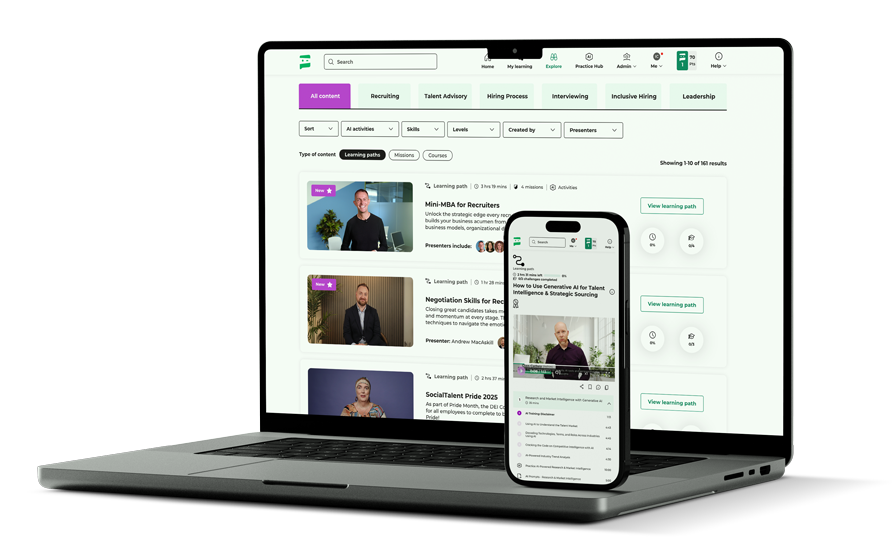
By David Deady
Have you ever felt overwhelmed trying to understand a new talent market for a role you’ve never recruited for before? You’re not alone. Traditionally, mapping the talent landscape has been a labor-intensive process – gathering data from competitive job postings, compensation databases, networking events, and spreadsheets. And even after all that, you’re often left with fragmented, outdated information.
But that’s changing. As Glen Cathey, sourcing and recruiting expert, puts it in his latest content on Using Generative AI for Sourcing and Recruiting the SocialTalent platform:
“Imagine having a seasoned industry expert instantly available to help you decode the landscape, analyze compensation trends, and identify where your target talent is concentrated. That’s the power of generative AI and market intelligence.”
Today, recruiters can leverage AI tools to quickly gain insights that would have taken days – or even weeks – to compile manually. By using generative AI effectively, you can act like a market analyst without needing a data science degree. The result? Faster, more strategic decision-making in a rapidly changing talent landscape.
This blog will walk you through how to use AI to understand the talent market – from crafting smart prompts to validating your findings. Plus, we’ll share Glen’s expert tips from his course to make sure your approach is practical, accurate, and ready for real-world recruiting.
Why Use AI for Talent Market Intelligence?
Understanding the talent market used to be a bit like detective work – poring over compensation databases, tracking competitive job postings, attending industry events, and maintaining spreadsheets just to piece together a snapshot of what’s going on. It’s labor-intensive and prone to gaps, especially when roles are niche or the market shifts quickly.
As Glen points out, AI can revolutionize this process:
“With generative AI, you can rapidly generate comprehensive insights that would typically take days to gather. Think of it as having a team of expert analysts working alongside you, processing vast amounts of market data in seconds.”
The Old Way vs. The New Way
| Traditional Approach | AI-Driven Approach |
|---|---|
| Manually tracking job postings and compensation | Automated market analysis with AI tools like ChatGPT |
| Networking at events for hiring trend insights | Real-time data aggregation and trend identification |
| Maintaining complex spreadsheets | AI-generated summaries and comparisons |
| Checking multiple sources for accuracy | Cross-referencing data in seconds with AI |
Key Benefits of AI-Driven Market Intelligence:
- Speed: Insights that once took days are now available almost instantly.
- Scalability: Analyze multiple roles, industries, or locations without being overwhelmed.
- Accuracy: Use AI to pull in verified, up-to-date information, reducing the risk of outdated data.
- Strategic Clarity: Gain a comprehensive view of talent availability, compensation trends, and hiring hotspots.
When AI Works Best:
- Exploring new or unfamiliar markets
- Understanding compensation trends and market demand
- Mapping talent availability for high-volume hiring
Where AI Falls Short:
- Niche Roles: Data can be sparse or non-existent.
- Specialized Knowledge: AI can’t replace deep industry expertise or human nuance.
- Data Gaps: Generative AI relies on publicly available data, which may not cover niche markets or emerging roles.
The key takeaway? AI is a powerful assistant – but it works best when combined with traditional research and a recruiter’s instinct. Glen emphasizes that while AI can deliver speed and breadth, recruiters must still validate findings and apply context.
How to Use Generative AI to Map the Talent Market
Leveraging AI for talent market insights isn’t just about running a few quick searches. It’s about being strategic with your prompts and smart about validation. Glen Cathey emphasizes that AI works best when recruiters treat it like a tool – not a crystal ball.
“The goal isn’t just gathering information, it’s developing actionable and accurate intelligence that improves your sourcing and talent strategy.”
Here’s a step-by-step guide to making the most of generative AI in your market analysis:
1. Choose Your Tools Wisely
Start by selecting AI solutions that offer internet connectivity and access to real-time data. Some top picks include:
- ChatGPT with Browsing
- Microsoft Copilot
- Perplexity
- Gemini
- Google’s Deep Research
These tools can pull from vast amounts of publicly available data, but remember: they only access what’s out there. If your role or market is niche, you might still need traditional methods.
Pro Tip: Always double-check the knowledge cutoff date of the AI you’re using. This ensures you’re not relying on outdated data for your insights.
2. Craft Effective Prompts
The quality of your output depends on the clarity of your input. Be specific and guide the AI to focus on verified, credible sources.
Here are some sample prompts to get you started:
Market Mapping Prompt:
“Act as a talent intelligence expert. Using only verifiable data sources, analyze the talent market for software engineers in the state of Texas. Please provide, with citations, talent supply, growth trends, major employers, geographic hubs, and any market events impacting supply and demand.”
Compensation Analysis Prompt:
“Using recent salary surveys and reputable market data sources, research compensation ranges for quantitative analysts in New York City, including base, bonuses, and equity by experience level and education.”
Comparison Prompt:
“Compare the talent markets for machine learning engineers in Seattle, Austin, and Atlanta. Include market size, compensation ranges, growth trends, and unique characteristics. List primary data sources and limitations.”
3. Validate and Cross-Reference
AI can give you a head start, but it shouldn’t be your only source of truth.
- Ask for sources: “What specific reports or data sources back up these findings?”
- Cross-check with reliable industry data: Use tools like LinkedIn Insights, Glassdoor, or official labor statistics to verify.
- Follow up for clarity: “What are the limitations or caveats associated with this data?”
Glen’s advice is clear: “Specify the need to differentiate between verified facts and AI suggestions. If the AI can’t verify a claim, state that clearly.”
The Human Element: AI as an Augmentation Tool
AI can be a powerful ally in understanding the talent market – but it’s not a replacement for human insight. While AI can rapidly aggregate data and present trends, it lacks the context and judgment that recruiters bring to the table.
Glen highlights that the true value of AI lies in augmentation, not automation:
“The goal isn’t just gathering information, it’s developing actionable and accurate intelligence that improves your sourcing and talent strategy.”
Why Human Judgment Still Matters
- Contextual Knowledge: AI might highlight somewhere as a tech hub, but recruiters know that talent pools can vary between specific neighborhoods or industries.
- Candidate Expectations: AI can list compensation trends, but recruiters understand how those trends align (or don’t) with candidate expectations.
- Culture: No algorithm can fully assess how well a candidate’s values and personality align with a company’s culture.
AI + Human Insight = Strategic Advantage
By combining AI-driven data with your recruitment experience, you gain a well-rounded view of the talent market. Start with AI to get a quick landscape overview, but validate findings with industry contacts, data from reliable sources, and your own understanding of the role and location.
The smartest recruiters in 2025 aren’t just fast – they’re informed. They know how to balance the speed and breadth of AI with the nuanced understanding that only human experience can provide.
Conclusion: Stay Ahead of the Curve with AI
Leveraging AI to understand the talent market doesn’t just save time — it transforms how recruiters can strategize and respond to changing demands. When used wisely, AI insights can pinpoint talent hotspots, uncover compensation trends, and guide smarter sourcing decisions.
But as Glen Cathey reminds us, AI should support human judgment, not replace it. Recruiters still need to apply context, validate data, and bring the human touch to every insight. AI can map the terrain, but it’s up to you to navigate it thoughtfully.
Get in touch with the SocialTalent team to learn more about integrating AI into your talent intelligence efforts.




